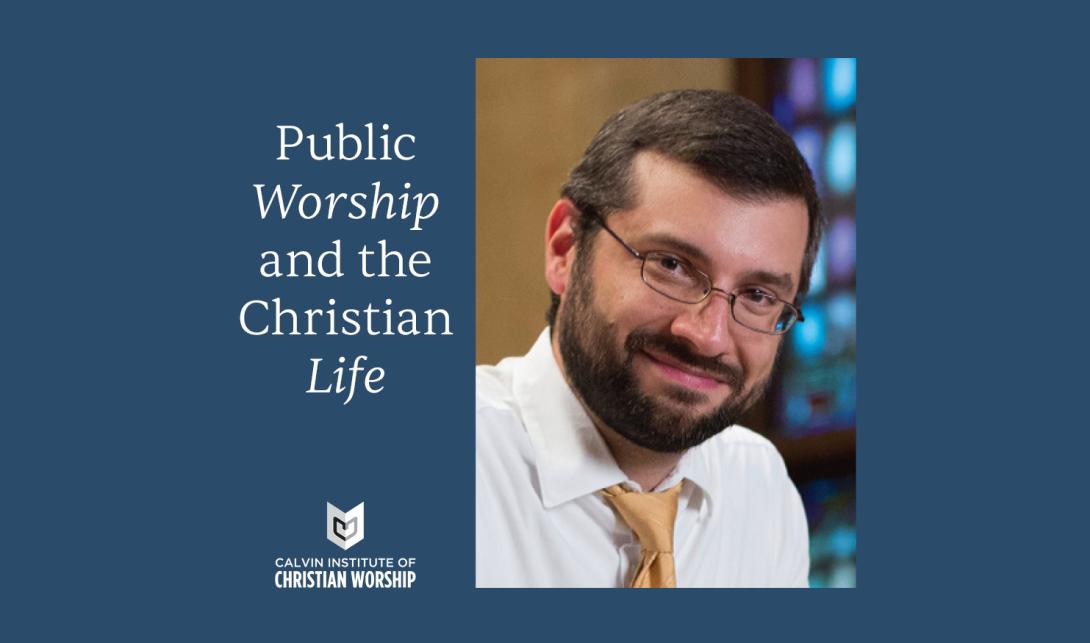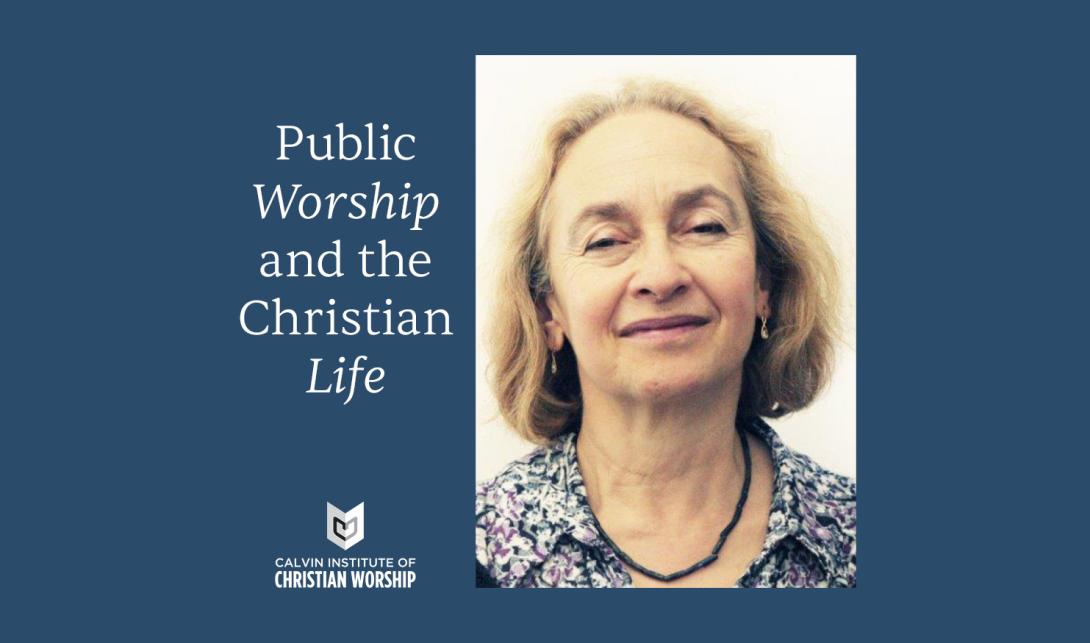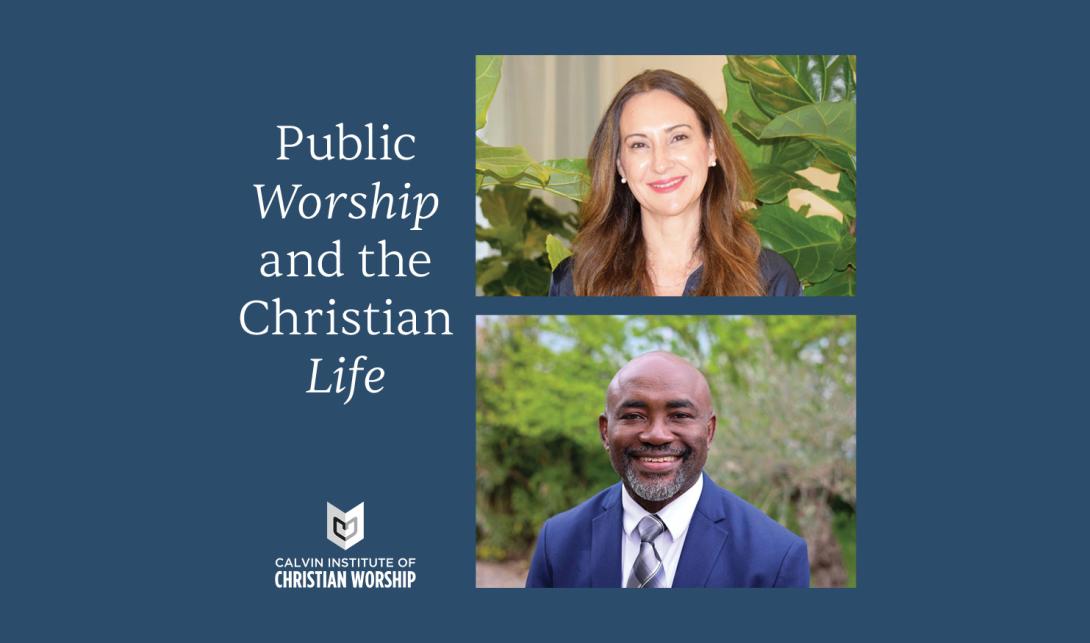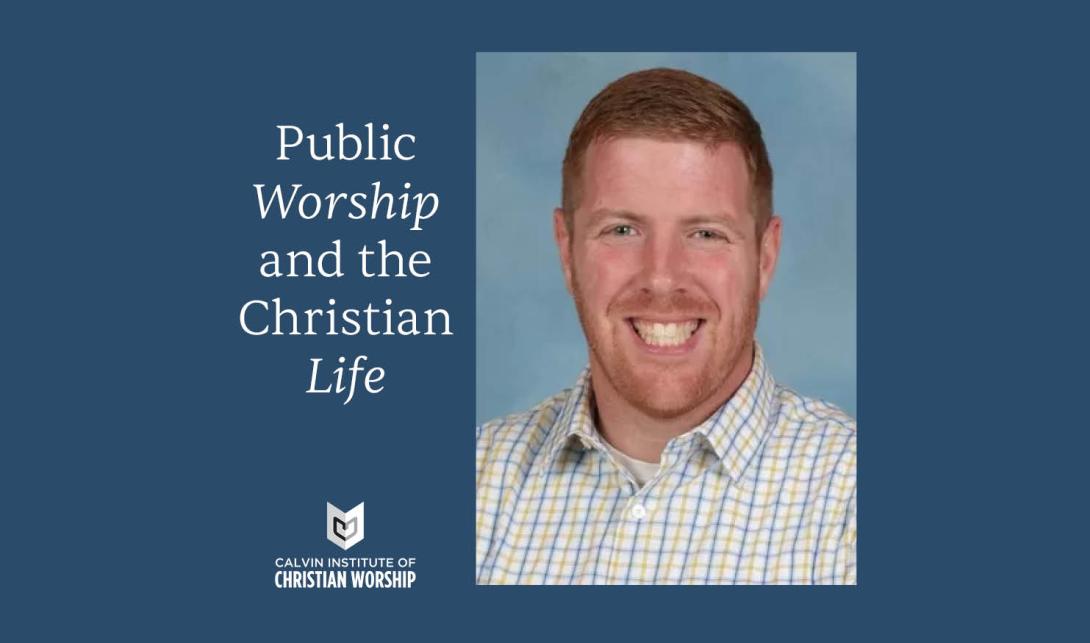Listen on Spotify, Google Podcasts, Amazon Music, Pandora, RSS Feed.
Episode transcript:
Host:
Welcome to Public Worship and the Christian Life, a podcast by the Calvin Institute of Christian Worship. In this series of conversations hosted by Calvin Institute of Christian Worship staff members, we invite you to explore connections between the public worship practices of congregations and the dynamics of Christian life and witness in a variety of cultural contexts, including places of work, education, community development, artistic and media engagement, and more. Our conversation partners represent many areas of expertise and a range of Christian traditions offering insights to challenge us as we discern the shape of faithful worship and witness in our own communities. We pray this podcast will nurture curiosity and provide indispensable countercultural wisdom for our life together in Christ. In this episode, David Stubbs, professor of ethics and theology at Western Theological Seminary in Holland, Michigan, and John Witvliet, professor of worship at Calvin Theological Seminary in Grand Rapids, Michigan, have a conversation about the multiplicity of meanings of the Eucharist and what it means to bring our whole selves to the Lord's table. This conversation is sparked by David's new book Table and Temple: The Christian Eucharist and Its Jewish Roots.
John Witvliet:
You've released a remarkable book, a substantial book, a reflection of many years of teaching and work. And I'd love to hear about the motivation that gave rise to this project.
David Stubbs:
The idea from the book came out of the previous book I was working on. So I'm a theologian and ethicist, but I was asked to write a commentary on the book of Numbers. And so it was part of this Baker/Brazos series that was asking a lot of theologians and ethicists to reengage with scripture, not asking so much historical critical questions, but asking theological and ethical questions. I said yes, after pondering the question about whether I should devote so much time to the book of Numbers, and I fell in love with the book. It is an absolutely amazing book. The first part of the book is the last moments on Mount Sinai. I think it sums up so much of what's happened on Mount Sinai and part of that has to do with the worship life of Israel. I spent a long time researching into this and I started making these connections between what I was learning about of the temple practice, of tabernacle and temple. And I was starting to make these connections between that and the Eucharist. I started looking around at Eucharistic theology and I thought, why has not anyone told me about this before? I looked around and I had a hard time finding anybody talking about these connections that I was seeing. And certainly there's a couple, there's just a handful of people who are beginning to make this. I became intrigued and I thought maybe this is something I need to do and draw out these connections. The more I thought about it, the more I thought it was a worthy project and also a life-giving one for me too. And so that was that was the beginning of the project. It took me a long time to do the work and trace all these connections out, but it's been a rich project for me.
John Witvliet:
Beautiful. So if I were a student in one of your classes and asked for you, what's the most theologically significant connection between temple and table, what would you identify? there are so many layers here, but what for you strikes you as seminal?
David Stubbs:
I don't know if I'd put just one. One of the things that I did in the book was try to organize the book and my thinking around five central meanings of the Eucharist. And these relate to the temple itself. What does the temple mean? And then also the central practices that were at the temple. I named first of all the daily, weekly, and monthly worship, which had a similar theme. And then these three pilgrim feasts, which would be Passover, Pentecost and the Feast of Booths. And so it's those five central aspects of the temple--one is the temple itself, and then those four main practices--that for me began to translate into the central means the Eucharist itself. For me, a breakthrough was when I finally decided, I'm going to structure the whole book around this. And then it felt like the book wrote itself.
John Witvliet:
What if we spend a minute and work backwards, thinking about those pilgrimage feasts. In that area, what stands out for you? I think of how many students, new believers, children might hear a little bit about Passover but not really understand the broader context and then how the meaning would go, what the connection is. Take us into that.
David Stubbs:
First of all, that's the one pilgrim piece that I think people readily connect with the Eucharist and the Last Supper, but Passover's remembrance of past deliverance. And so for the people of Israel, it was the deliverance from Egypt. For Christians, they look back and they see the work of Christ and they remember Christ and his work and his life, death, and resurrection as a remembrance of that deliverance. And moving forward to Pentecost, then: the central saving event that Pentecost is built around is the giving of the law on Mount Sinai. And so for them, it was a covenant renewal feast. For us Christians we also celebrate the new covenant sealed in Christ's blood given for you. So that becomes a central meaning as well. And then the Booths was a foretaste of the feast to come, which (are) common Eucharistic words. That's---actually, today is the beginning of that celebration for the Jewish people today. So starting with Rosh Hashanah and then moving through the Day of Atonement, and finally into the great feast. And so the Eucharist also looks forward to a great feast to come. And so remembrance, covenant, communion, and hope become the central aspects of both the pilgrim festivals, but then also those central meetings in the Eucharist.
John Witvliet:
It strikes me, we run up against the tendency to want to explain in broader Christian culture to come up with very simple single definitions. And you're here saying--and I try to do this in my teaching too--the Eucharist can beautifully mean more than one thing at the same time. And in fact, that's the whole power of it, right? It's the multiple meanings that are there. How do you find students responding to that multiplicity, that abundance of meanings?
David Stubbs:
That's a challenge. One of the things is that I've used several metaphors to describe the Eucharist. It's like a gem with different facets to it. For me, it's like a microcosm, or a fractal is one that is meaningful to us. So for me, it becomes kind of this place where the entire story of salvation is told and retold. And so there's different--even though it's unified in some ways, it often . . . it's a place where these central aspects of what it means to be a Christian are summarized and presented. People often think about sermons and they ask the question "Was the gospel preached?" I think every time that you do the Eucharist, the full gospel is preached. And so it becomes a larger summary of our entire Christian faith.
John Witvliet:
What do you think this multiplicity of meanings has to do with how we celebrate the feast? Are there ways of engaging in the celebration that can bring out these multiple meanings? I was struck in the book by, especially toward the end, your powerful testimony about how practices at the table in your own seminary community at Western have been so influential for you.
David Stubbs:
You might have to rephrase the question again. I think you're asking how do some of those meanings get fleshed out into the practices?
John Witvliet:
Right. And how do we practice it so that we don't slip back into "This one action means exactly one thing." How do we keep alive the multiplicity of meanings in how we go about it?
David Stubbs:
I think there are a number of different ways. In the last chapter in the book I tried to answer that question and point out everything from the architecture of the buildings or worship spaces that we have--that's relevant; the different aspects of how we celebrate the service; as well as most centrally the communion prayers that we have. They can note all these different aspects of the meanings of the Eucharist. I think it's also helpful to have some teaching around it. Tell people what the Eucharist means. . . . it's like going to a soccer game. If you know the rules of the game, you're going to enjoy a lot more and it will be more meaningful for you. There're ways that we can, as we approach the table, that we can bring our whole selves and open ourselves to all the different things that God has for us in it.
John Witvliet:
Beautiful. Incidentally, one of the things that struck me about the book is the powerful way that it breaks down so many categories. Is this a book about the Bible? Yes. Is it about theology? Yes. Is it about the practice of the church? Yes. Is it about ethics? Yes. It strikes me that this is not a sales pitch from the publisher, but it could be a textbook in just about any class at a seminary. David, I think you pulled it off.
David Stubbs:
Well, let's hope. [laughter] No, it's interesting, John, I noticed that about the book and even about my writing. I start off with the preface by talking about making connections. And for me, I want to figure out how the world works, how God is, what we are as human beings. And so for me, everything needs to be connected. I try to limit myself a little bit in the book, but I see a lot of these connections to different aspects of our theology, our practice, or our lives, the history of the church.
John Witvliet:
Let's go back to a couple of those other dimensions, the temple and temple practice. You mentioned daily prayer, not just the annual pilgrimage feasts, but these other recurring practices that were so central in ancient Israel. How do you see the connection there?
David Stubbs:
That was one of my big learnings as I did the research for the book. At first, I had to figure out what this meant. And when I looked into the daily, weekly, and monthly worship services, I saw that they were really about thanksgiving to God for creation. They were very creation-centered rather than a specific kind of saving work that God had done. I thought, wow, this is really interesting, and perhaps problematic because I hadn't often thought about the Eucharist as being very creation-centered. But if you go back to some of the earliest church documents, you find that's in the early church practice as well. I think that there are a couple things where I think this book could make a difference or a change in how people see things. I think that this could be one of them, is that I think that this kind of bass line--think of these like bass line and then higher melodies--but this recurrent bass line of a thanksgiving to God for creation and a recommitment to be wise creatures in the midst of our world can be and should be part of our Eucharistic practice as it was part of the daily, weekly, and monthly celebrations at the temple.
John Witvliet:
Fascinating. Absolutely. And then the fact that the Eucharist uses the gifts of creation, and the tangible nature of that, and perhaps that's a natural leading to the other connection you had mentioned, which is the temple itself--the architecture, but the very fact of its existence and the connection there. How would you describe the connection there?
David Stubbs:
There's a lot to be said about the temple. One, is there a place where God is present? And we often talk about real presence. That's a word that we use when we talk about the table and God was really and personally present at the temple to meet with the people of Israel, as I would describe it, to both meet with them as well as give and receive gifts. I think that it's a place where God is really present and where gifts are exchanged. The temple also represented this inbreaking of the kingdom of God into the world and how the details of that you can see in different aspects of the architecture of the temple. God's throne is there in the Holy of Holies, the Table of the Bread of the Presence, which had flagons of wine on it was there, and it represented God's rich, abundant life that life together with God in God's presence that would bring for all of Israel and for the entire creation. So there's many aspects of what the temple as a whole meant, as well as details of the architecture, that has a lot of meanings that you can see these connections to the Eucharist as well.
John Witvliet:
I've been moved by several accounts and scholarly literature of these Old Testament narratives that have so clearly linked the creation account in Genesis with the design of the tabernacle or temple, and trying to imagine this temple as an echo of Eden or better to say in some ways, like you say, a prefiguring of the completely renewed, redeemed, restored, and completed kingdom of God in the new creation. One of my challenges is trying to invite students into that big vision. There's an interpretive move there from saying, Oh, let's memorize the parts of the architecture or something where you're looking at a very flat level, to seeing this powerful source of meaning. Any reflections on what you found successful there, how you're going about it? How do we invite students to see what is of life-changing significance about how God is at work within creation itself?
David Stubbs:
There's a lot of questions and sub-questions wrapped up into that. I like to invite people into some of the biblical imagery as ways of thinking about how these connections might work. Take, for instance, the ladder of Jacob. The temple--people may not know this, but Jacob had this dream and he dreamed of this ladder with angels ascending and descending. Rabbinic tradition has the very stone that Jacob's head was lying on became the foundation stone of the temple. The temple is this place where there's this connection with God and God's kingdom. I like that either the ladder of heaven, or a pillar of cloud and fire, which is above it to show that connection. And then the second part of the imagery, I think, is these rivers of living water, which are flowing out of the Garden of Eden, or flowing out at the temple, or, in the words of the prophet, justice is rolling down like water from the Temple Mount. That combination of imagery is a ladder to heaven and then this kind of flowing out of the kingdom of God into all creation around it is a complex imagery, how I'd like people to see both what was going on at the temple and then hopefully also seeing what's going on as we gather as the people of God around bread and wine and invite God into our midst and celebrate the Eucharist together
Host:
You are listening to Public Worship and the Christian Life: Conversations for the Journey, a podcast produced by the Calvin Institute of Christian Worship. Check out our website at worship.calvin.edu for resources related to this topic and many other aspects of public worship.
John Witvliet:
It strikes me that a lot of this work depends upon these evocative and rich scriptural metaphors and that it's not just the cognitive exercise you're inviting us into. This is an imaginal exercise, absorbing these metaphors. Say more about that both in your own life and in your teaching. Sometimes people think theology is about the cognitive engagement with ideas. I think your book's ample testimony that it's about a lot more than that.
David Stubbs:
It's really interesting. In Christian ethics class this morning, we were talking about images and how even the Christian ethical life is often lived in light of different biblical images like the kingdom of God. I think those things are--well, you could say not simply I; Jesus thought they were really important as he's doing his teaching. He's giving these people these images by which to structure their life and their response and how they should live their lives in his parables and his teaching. There's one book I was talking with people about this morning by Austin Farrer--it was called Glass of Vision--and he talks about that Jesus took--he names five master images from the Old Testament, and he explained what he was doing in light of these images. Austin Farrer has this great line . . . where he says that Jesus took these images, wrapped them around himself like a cloak, and then died in them or something like that. But it's beautiful to think about perhaps God and Jesus' strategy for teaching the people of God, and it has a lot to do with symbols and images, and maybe we should learn something from them.
John Witvliet:
Powerful. David, as you look forward, now that you've completed this project, what does it make you curious to learn more about? What trajectories does it send you on as you continue in your own teaching and learning and growth?
David Stubbs:
That's a great question. My next scholarly angle that I'm going in, I'm looking at restorative justice. And in some ways you could say I'm taking off my theology and worship hat and putting on my ethics hat. But for me, this whole book has shown me the connection between those, and how worship is not simply about this spiritual exercise disconnected from the rest of our lives, but the whole meaning of the Eucharist is this is a place where the kingdom of God is breaking in, and then it needs to flow outward into the rest of the world. So may justice roll down like the waters, and I think worship becomes at the center of our life. We often talk about worship is a place where we breathe in and then we need to breathe out into the larger culture. Those connections between worship and the rest of our lives, worship and ethics, are so critical for me. And I want to keep on ringing that bell.
John Witvliet:
That's good. Very good. 1 Corinthians 11, when it challenges the division of the Eucharistic community along socioeconomic lines, and Paul says, "It's not about that at all." That's about as vivid an illustration in the New Testament I can think of to those prophetic texts about justice. So the connection's there for you. I love it. That's great.
Now say more about the practices of the table. We talked about this a bit, but one of the things I know we both long for is churches to continue to grow and to lean into the richness, the beauty, the evocative power in the way that these multiple layers of meanings are also so accessible to people at every step in their journey in the Christian faith. One of the things I find myself struggling with is the tendency of some churches to want to keep simplifying and narrowing and shortening a table celebration, making it an optional appendix to a worship service for those people who happen to be interested in that sort of thing, or trying to get through it as quickly as possible. I'm showing my cards here very clearly about some stuff. . . . But yes, as I got toward the end of the book and I'm reading your invitation, it's certainly about keeping this accessible, buoyant in the deepest kind of way, invitational and yet having it be of weighty significance--I think that is a term that comes to mind. Say more about your hopes for practices that would come from readers of this book.
David Stubbs:
For me, even in the preface I wrote about a lot of churches and a lot of places that had rich Lord's Supper or Eucharistic practices. And those places, how would you say, inspired me to know that I'm not just writing about some sort of academic thing, but that it actually does happen and it really matters in people's lives. And one of the things I've found too, and it's important for me--I hope this comes out in the book--is that I think sometimes when people think about improving the practice of the Eucharist, they often only have in mind very high church understandings of the Eucharist. And so they think very mystical, Roman Catholic, Episcopalian, and yes, that's great. And I also really like new, emerging, fresh expressions of the Eucharist. It feels very different, but it has the same richness of meaning. And it has been really important for people there too. What I'm trying to say is that I am excited to see people who come from very different kinds of worship traditions--low church, high church, emerging, old-fashioned, whatever--to see that this is for them. I've experienced it. From weird, funky churches in San Francisco that I was part of that was very dressed down, to more high church settings. And I've seen the Eucharist done both poorly in both kinds of settings, but also really richly [in a way] that's very meaningful for the congregations and everybody involved. So I hope that people will experience that in their congregations.
John Witvliet:
Who are some of the writers out there, other theologians, pastors, you think of, that have been helpful to you in this conversation or that you'd love to see this book engage in some way? If we were going to have a group--let's picture ourselves forming a reading group, and we're going to read your book and we're going to put it next to four or five others that could stimulate some wonderful learning and discovery. What writers come to mind?
David Stubbs:
That's a great question. Some of the people who make these temple connections would be Brant Pitre writing from a Roman Catholic tradition. Margaret Barker, she makes the connections, but I'm not quite sure she has contemporary worship practices in mind; it's more of a historical look at this. But people like James Torrance, his book Worship, Community, and the Triune God of Grace . . . James Torrance would be great. Jean-Jacques von Allmen, he was somebody important for me in my own practice. One of my mentors was named Geoffrey Wainwright, who wrote a very important book called Doxology. . . . and even his Eucharist and Eschatology, when I'm drawing from the Feast of Booths and think about eschatology, I drew a lot from Geoffrey Wainwright's books too. In terms of more writers that are really engaging with practice at a practical level, I found people like Robert Webber, maybe it's one generation ago, maybe we need new Robert Webbers coming out, you know, ancient-future church, ancient-future worship, people like that. Most of what you've written, John, would be on my list too.
John Witvliet:
Let's spend a minute yet before we conclude reflecting on the influence of Geoffrey Wainwright, and especially in light of his death in the past year, he was a significant person in my own formation. I once had a chance to audit his seminar in trinitarian theology at Duke while I was trying to write my dissertation, David. I didn't have as much engagement with him as you did, but would you say a bit about Professor Wainwright, his influence on you, and what you found compelling about his work and vision?
David Stubbs:
I'd love to. I did my PhD work at Duke. I loved it. I loved the people there. The three people who were most influential for me were Richard Hayes, Stanley Hauerwas, and Geoffrey Wainwright. I called them the scribe, the prophet, and the priest-king of the tradition. They had very similar angles, but they're very different people as well, and different in many ways. But Geoffrey Wainwright was so helpful for me in thinking about these connections between worship and theology, worship and ethics. And so you could say he gave me a vision for making these connections even as I did my work in theological ethics--it was Wainwright as well as Hauerwas. Hauerwas, if you look at his Blackwell Companion to Christian Ethics, he often structures his ethical thinking around the Christian worship service. For me, there's so many people who were engaged in kind of these connections between worship and theology, worship and ethics. It was rich. But Geoffrey Wainwright was of course a crucial person in that discussion. One more thing to say about Wainwright is he was involved a lot in ecumenical discussions. And I think that gave me . . . I've always been interested in the unity of the church, but that increased it for me. And he introduced me to Eastern Orthodoxy, him and Willie Jennings. And so even these connections with Roman Catholic and with Eastern Orthodox traditions, I would say that Geoffrey Wainwright spurred that in me as well.
John Witvliet:
It prompts me to think of how Professor Wainwright invited us all to set our sights on things quite grand, in a way, and weighty--Eucharist and Eschatology. The feel of the title and how he could master all of that, but then how he could carry it in his person with a sort of buoyancy and lightness of a sort.
David Stubbs:
That's lovely, John. I would agree with that description.
John Witvliet:
And I think that's a good way for us to move to our conclusion here, that there's something that does strike me about the book too, David, that Bible, theology, practice, all of the above, table and temple, New Testament and Old, these multiple images--it's like you're saying to us all, don't settle for a little bowl of porridge here. You know what I mean? It's like consomme, and it's for the sake of the world, ultimately, but let's carry it lightly in our person, but also not to stop short of all that we're invited into in Christ.
David Stubbs:
I think that's great. Going back to this idea of the Eucharist being this gem, we can go into some discussions about all sorts of traditions that center their thinking about the church on the Eucharist, but I understand that, because there's ways of understanding and engaging with the Eucharist, and I think God's intention for it was to be a place where so much of our lives finds its meaning and purpose, and it sums up the Christian life in so many ways. And so let's make it rich, because I think that was its intention, and for us to bring out all those different understandings I think would be a wonderful thing for us as Christian church.
John Witvliet:
David Stubbs, it's been a joy to be in conversation with you. May you be blessed by many readers of this book, and I know that your readers will be blessed as they engage with it. So thanks so much.
David Stubbs:
Thank you so much, John.
Host:
Thanks for listening. We invite you to visit our website at worship.calvin.edu to learn more about the Calvin Institute of Christian Worship, an interdisciplinary study and ministry center dedicated to the scholarly study of the theology history and practice of Christian worship and the renewal of worship in worshiping communities across North America and beyond.





